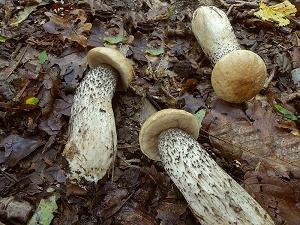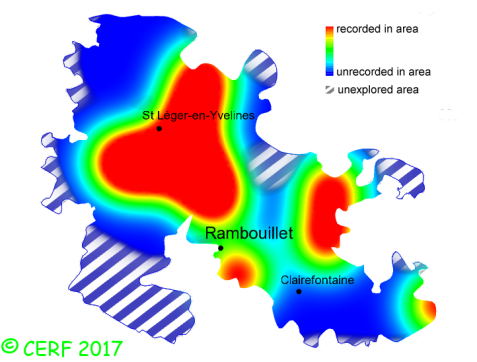| Leccinum versipelle (Fr.) Snell |
|
|
|
|
|
|
The cap is of a uniform colour, orange-yellow to pale yellow brown or pale orange-brown (more orange when young, the orange shades disappear with age), fleshy, firm, globular at first, then hemispherical, convex and finally flat-convex. The cap surface is dry to slightly viscid, finely downy then smooth, sometimes even scaly (at the centre), depending on weather conditions. The cap margin is overhanging, covering pores in young specimens. The stem is full, long and firm to tough, rough because of the small black to dark brown scales. It is cylindrical or swollen at the base. This stem base is often stained with blue-green, especially when pressed. The colour of the stem's background colour is whitish to grey, under the coloured scales.. The flesh is thick, firm, the stem being fibrous. It is white but becomes lilac-pink when in contact with air, then strongly blackish (the stem base becoming itself green-blue when exposed to air, then later turning black); its taste is faint or mild; the odour is weak or pleasant; The tubes are smoke-grey then yellowish grey, turning pink when cut and exposed to air. The pores are very small, round, mouse-grey (characteristic colour in young specimens), then yellow grey, becoming vinaceous red when pressed. The spore print is pale brown. It grows in dry and well lit deciduous woods, particularly in sandy heather moors, on a rather acid soil, essentially with birch mixed to oak, beech. The fruiting period takes place from June to December.
Chemical tests : The flesh turns brick-red when in contact with ammonia (NH3). Distinctive features : orange cap; mouse grey to yellow-grey pores; tough stem covered with small scales eventually black when mature; flesh turning black when exposed to air (stem base turning blue) mostly with birch Leccinum versipelle is quite rare and scattered in the forest of Rambouillet, and is occasional, more generally speaking . | ||
|
page updated on 14/01/18

